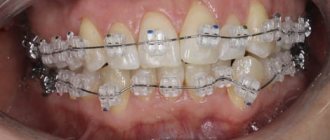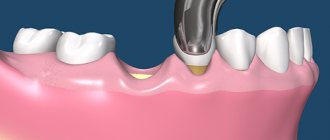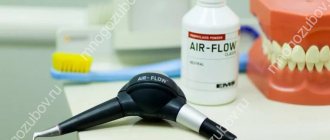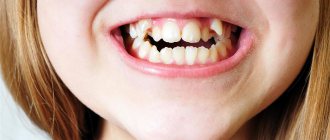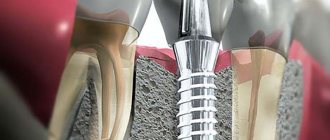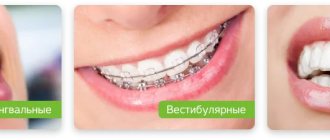If you are reading this article, it means that you are interested in improving your bite and are considering braces.
This shows that you have the determination to achieve a healthy, charming smile.
Here we have collected the questions that people most often write to us in messages.
I hope this changes your life for the better, just like it has changed the lives of thousands of other people.
Can adults get braces to correct their bite?
Anyone can correct a malocclusion, regardless of age. But in an adult, this process takes longer than in children, because skeletal growth has already stopped and hard bones are more difficult to form.
In addition, some oral health conditions may delay the installation of braces. For example, caries, periodontal disease, endocrine diseases.
Sometimes the effect of treatment is influenced by the presence of crowns and bridges. The treatment period starts from 1.5 years.
Slight crowding of lower incisors and canines
A prerequisite for installing braces only on the lower jaw is acceptable closure of the lateral sections of both jaws. But the doctor must determine in advance how much free space will be needed to straighten the lower crowded teeth with a brace system. And that's why.
The required space can be obtained in different ways. Expanding the row is unacceptable, since in this case it will lead to pathology - a violation of the closure of the jaws. What remains is the method of repairing dental crowns. Their contact surfaces are slightly ground - literally by 0.25 mm, which allows you to release 2-3 mm without harm to the teeth.
Thus, if there is a shortage of space up to 3 mm, it is possible to get by only with braces on the lower teeth. Otherwise, treatment will take place on two jaws.
Does teeth straightening hurt?
The installation of braces itself is painless, but requires patience because it takes about an hour.
For 7-10 days, teeth may hurt when biting. The body must get used to foreign objects. In general, you live your old life, you just notice pleasant changes in yourself.
Control visits are needed to correct the process and form the correct position of the teeth. Usually after changing the arch the pain goes away within 3-7 days. It all depends on individual sensitivity.
For some, wearing braces is only unpleasant, for others, on the contrary, it is painful, and some do not feel anything.
How to install the structure
Before using braces, you may need dental treatment for caries and other oral pathologies. After the orthodontic system is manufactured, it is installed on the teeth prepared for this. It happens like this:
- A bracket (clasp) is attached to each tooth and is fixed using a special adhesive composition.
- Each bracket is connected to the next archwire.
The features of this design make it possible to create a directed pressure of a certain force specifically on the curved teeth, which over time displaces or turns them in a given direction. The installation procedure does not cause any pain.
The duration of use of local braces depends on the type of pathology, its severity and the age characteristics of the patient, but most often it does not exceed ten months. Fragmentary braces can be placed on children when the baby incisors have been replaced by permanent ones, as well as when all the chewing teeth have grown, which is important for the quality of the system installation. That is, this is possible at the age of 8-10 years.
Do braces make it difficult to eat?
Once installed, you will need to learn how to eat in them. This period takes on average 3-7 days.
At this time, give preference to soft and liquid foods. Cut fruits and vegetables into small pieces. Avoid fibrous and sticky foods.
Over time, you will be able to eat almost everything except Coca-Cola (can dissolve glue), hard foods (nuts, crackers, chocolate) and sticky sweets (chocolate, cookies or caramel bars). You should also not chew gum.
What problems can arise with a retainer?
The first thing a person who has a permanent retainer installed will face is getting used to it. At first, the retainer may rub your tongue, feel too big in your mouth, and interfere with clear diction. The retainer becomes invisible in the mouth after about a week.
The next task for a patient with a retainer is careful home hygiene, since food debris can get stuck in the spaces between the teeth and the retainer. For home cleaning, we recommend using a single-tuft brush, brushes, dental floss and irrigator.
The retainer may break or come off due to hard foods. In this case, you need to contact your doctor for a replacement.
If caries appears in the area of the retainers on the teeth, then for treatment by a therapist, the retainer will need to be removed and then reinstalled.
How often should inspections be carried out?
Every 1-2 months, it all depends on the defect and the individual structure of the patient’s teeth. During the visit, the orthodontist checks the success of the treatment and sets a vector for the arch, which determines the movement of teeth in the right direction.
Missing follow-up visits may negate the effect of previous treatment. You are also required to visit a hygienist every six months.
Braces, whether external or internal, need to be worn for an average of 1.5 years. But determining more precise timing depends on the initial situation and age of the patient. Sometimes it takes 2 years to eliminate a defect.
Metal braces: reviews
Metal braces are the most common and most reliable type of braces. Typically, they are made of stainless steel, gold-plated steel or titanium (the latter used for allergies to nickel, which is part of the steel). Metal braces typically have the smallest sizes of all types of braces, but keep in mind that sizes vary slightly between manufacturers.
Metal braces are slightly less expensive when compared to sapphire and ceramic braces, but they are significantly less expensive than lingual braces. Metal ligature braces are especially accessible - their price will be on average 1.5 times lower than non-ligature braces. However, there are exceptions here, for example, for non-ligature braces “Forestadent Quick” (Germany) - the price for 2 jaws starts from 125,000 rubles, which is quite consistent with the cost of ligature braces.
Ligature and self-ligating braces (made of metal) –
The only disadvantage of metal braces is that they are clearly visible on the teeth. But you can personalize them and make them colorful by using colorful rubber ligatures. And for the most fashionable ones, it is possible to install braces in the shape of hearts, flowers, soccer balls or stars. See Table 2 for all the advantages and disadvantages of metal braces.
What to do if the bracket comes off?
In itself, this happens quite rarely, only in cases of severe crowding of teeth, since the arch puts a lot of pressure on the dentition and the lock falls off. Another option is if the patient is a nut or other solid food lover.
If you find a broken bracket, contact your orthodontist immediately. Otherwise, the teeth will begin to gradually move to their original position. Also remove elastic bands if you wear them.
The doctor sees patients with unstuck braces out of turn. It takes about 5 minutes to glue a new lock.
It also happens that the archwire flies out of the bracket grooves. You can try to get it back yourself. However, this should be done extremely carefully, without damaging the adjacent locks.
Under what conditions are braces used? are they used locally?
Partial braces are indicated for use in certain dental conditions. Namely, the closure of the molars must be correct, as well as the placement of the canines. Such ideal condition of the dentition is very rarely observed. Therefore, most often orthodontists use braces for the entire dentition for correction. However, partial use of braces is possible for the following pathologies:
- Noticeable interdental spaces;
- Incorrect tooth inclination;
- The tooth protrudes from the dentition;
- Incorrect rotation of the tooth;
- Slight curvature that disrupts the dentition.
All this can only be noticed with a certain dental examination, which involves visual and manual examination of the oral cavity, taking impressions, and then making models of the dentition from plaster. An x-ray and possibly a computed tomography scan are also needed to give an idea of the condition of the teeth and jaws. Only after diagnostic procedures can you confidently select one or another braces system.
How to brush your teeth with braces?
This is where a traditional toothbrush and toothpaste don't serve their purpose. Therefore, you will need to buy a special orthodontic brush, brushes and floss from the pharmacy. You can also use an oral irrigator if you wish.
This way you can effectively clean your teeth and the area around the locks. Teeth should be thoroughly brushed after each meal, because food debris is deposited on braces, which contributes to the development of caries and does not look aesthetically pleasing. We have repeatedly encountered patients whose teeth are more well-groomed than those of a person without braces.
Removable braces: pros and cons
Removable mouthguards, trainers or plates have a number of advantages, namely:
- due to the tight fit to the teeth and the transparency of the material used, they become invisible to others;
- quick adaptation and absence of discomfort;
- easy hygiene procedures (mouth guards can be easily removed and put on independently);
- the possibility of wearing the structure to school-age patients, which allows the procedure for correcting the bite to be carried out at the stage of its formation;
- are worn 11–15 hours a day, which makes it possible to go out into public places without wearing plates;
- makes it possible to wean a child from bad habits that can affect the formation of malocclusion;
- well suited for children who refuse to walk with fixed structures;
- specially inserted screws into the plates allow you to slowly and painlessly expand the jaw bones;
- help to consolidate the result obtained after correcting malocclusions with non-removable braces, protecting the teeth from returning to their original location.
The disadvantage of removable systems is the impossibility of treating bite pathologies with large deviations. Treatment with these types of orthodontic structures is not limited to the age category of the patient, but is more often used to correct pathologies in children.
Are braces the last stage of orthodontic treatment?
After removing braces, you need to consolidate the effect of straightening your teeth. For this purpose, retainers are made that will protect teeth from returning to their original place.
There are two types of retainers:
- Removable – transparent, plastic mouth guards. Used only at night or during a certain period.
- Non-removable - made of metal. They are installed on the back surface of the teeth using special composite materials.
The decision on the best method is made by the orthodontist. The aligners must be worn at all times during the first month, removed only for eating and brushing your teeth. On average they are worn for 2 years.
While wearing retention devices, you must visit a doctor every 3-6 months.
Types of bracket systems
Installation principle systems are defined as:
- vestibular - the classic form of the device, attached to the outer part, visible,
- lingual - fastening on the internal (lingual) part, not accessible to view from the outside.
The designs are: ligature - the use of elastic bands, replaced with elastic ones as the bite is straightened, and modern non-ligature instruments.
Note! Lingual differs from vestibular not only in the high cost of maintenance, but also not in ease of wearing: a foreign body installed on the inside often wants to be explored with the tongue, which causes injury and affects diction. In addition, an “invisible” device is more difficult to care for.
When choosing a lingual system, you can install braces only from all-metal material; for vestibular installation, there is a wide selection of types of brackets.
Metal braces are standard steel components and a steel ligature, which in the new design have been reduced in size, reducing the inconvenience caused to the user.
Advantages:
- ease of use,
- comfortable care when wearing,
- low price,
- efficiency,
- In the case of ligatures, children and adolescents can choose the color of the rubber bands to determine their individuality.
Flaws:
- noticeable.
Plastic
Plastic braces are designed to correct minor irregularities, as they do not have sufficient strength and cannot affect severe irregularities and curvatures.
Advantages:
- unusual design,
- They are made transparent, making them practically invisible.
Flaws:
- turn yellow and wear out,
- do not have a strong impact, increasing the time period.
Ceramic system
Ceramic braces - made of ceramics matched to the enamel tone to reduce visibility.
Advantages:
- aesthetics,
- By choosing a ceramic tone that is a shade lighter than natural enamel, you get a whitening effect.
Flaws:
- are more expensive
- more time is spent on care.
Sapphire braces
The sapphire braces system is characterized by being made from artificially grown sapphires, which, due to the refraction of light, become transparent on a dazzling smile.
Advantages: not visible to outsiders.
Flaws:
- impressive price,
- exclusion of any products that can damage the components (nuts, snacks, hard vegetables and fruits).
Titanium
Titanium braces are a metal type, the main material of which the device is made is titanium.
Advantages:
- hypoallergenic,
- strong and durable, suitable for changing “neglected” cases.
Disadvantages: noticeable to prying eyes.
The dentist may suggest installing a combined design of braces: ceramics on the front ones, and a classic prefabricated metal bracket system on the “invisible” rear ones.
How does this happen?
You need to start working on correcting the curvature with an individual consultation with a specialist. During the appointment, the doctor assesses the condition of the oral cavity through examination, x-rays, taking impressions, and selects the best braces to correct the situation.
The most informative is a 3D image of the cavity, offered by most modern reputable clinics. This diagnostic method will be more expensive, but it is the most accurate for determining the scope of work.
Next comes oral debridement:
- detection of caries disease,
- treatment of caries in fact,
- thorough hygienic cleaning,
- in the absence of support for fixation, the issue of future implantation is decided.
Installation of braces (one row per visit) lasts about 2 hours, depending on the complexity of the case: the specialist prepares the surface, installs the bracket and attaches the arch to them. The procedure is absolutely painless.
Correction is necessary every 1-1.5 months until the problem is completely eliminated:
- metal - 1-2 years,
- ceramic and sapphire - up to two years,
- lingual - 1-2 years.
Removing braces involves opening the “locks” of the system, removing the thick fishing line and removing the “squares” with special tweezers. Next, the doctor will install a retainer (steel wire) on the inner surface of the teeth, or offer a transparent plastic tray to secure the achieved result. The retention device will remain with the patient for at least a year. After removal, the doctor polishes the enamel and coats it with fluoride (varnish or paste).
What is the price
The answer to the question of how much braces cost can only be given by determining the factors that influence the cost:
- The degree of complexity of the initial problems, the number of crooked teeth,
- the straightening method chosen by the patient (metal is cheaper than sapphire and ceramics, internal is more expensive than external),
- material of components,
- availability and preparedness (a template version may be suitable for the user, or custom-made may be necessary),
- brand (domestic or foreign)
- the need for preparatory work (getting rid of carious stains, pulpitis, placing a temporary crown).
Don’t forget about a monthly visit to the orthodontist for arch correction and oral hygiene. The final cost is the sum of the drawn up treatment plan and is necessarily specified in the contract or agreement, as well as the method of payment (immediately or in installments).
On average, taking into account all factors, the average price for titanium devices is from 80 to 150 thousand rubles per jaw, sapphire ones will cost from 100 to 250. Lingual brace - up to 300 thousand rubles.
The choice of suitable structures depends on the knowledge and skills of the orthodontist, patient reviews, and before and after photos.
You should not skimp on your bite when the bones of the jaw and skull are involved, affecting the overall health of a person. Choose professional dentistry carefully and do not chase promotions and unprecedented prices.
Can you continue to live with crooked teeth?
Crooked teeth are more vulnerable to tooth decay and periodontal disease. If teeth grow incorrectly, their surfaces become excessively worn down when eating, which worsens the malocclusion. Therefore, sometimes it leads to serious diseases of the temporomandibular joints.
In addition, if you suffer from frequent headaches, chondrosis, or have tinnitus, it is better to check your bite.
When are aligners installed?
- Trema, diastema;
- crowding of teeth (up to 6 mm);
- shortening or lengthening of the incisors (vertical anomalies of occlusion);
- rotation (wrong position) of the dental unit;
- the tooth deviates forward and backward;
- upcoming prosthetics or implantation.
The duration of treatment with aligners depends on the severity of the disorder. The course of correction can take from 8 months to 2 years or more. Each design has an individually specified trajectory of the action of weak forces on the dental units. One device displaces an abnormally located tooth by 0.2-0.3 mm. How many correctors are required for a set depends on the situation - the simpler the problem, the fewer aligners are needed.
The first pair of devices corresponds to the initial clinical picture; each subsequent pair includes adjustments to change the position of the teeth. The last pair displays the treatment result.
Braces hurt the oral cavity, what should I do?
After installing braces, each patient receives wax for locks from the orthodontist. At the very beginning, it is worth applying it to the entire system, because the mucous membrane in the oral cavity is not yet accustomed to contact with foreign objects.
Abrasions and wounds heal very quickly. Their healing can be accelerated by using agents that promote the healing of wounds in the oral cavity.
Fixed retainers
A permanent retainer is a wire arch made of medical steel, which is attached to the inside of the teeth with a special compound. This type of retainer is used most often, as they are completely invisible, cannot be felt in the mouth and do not oxidize. Fixed retainers can come off due to mechanical stress, such as chewing hard food. In this case, you should immediately visit the orthodontist and return the retainer to its place to prevent the teeth from moving.
Fixed retainers have many advantages: you can’t forget to put them on - they are always on your teeth, and they are absolutely invisible and do not interfere. The main feature of wearing a fixed structure is the need for careful home hygiene and professional cleaning every six months at the dentist, since plaque in hard-to-reach places around the retainer is more difficult to clean.
Is it possible to get braces instead of implants?
Moving adjacent teeth into the socket of the removed one is a common alternative to implantation. In terms of timing and price, these procedures differ little. Not all orthodontists undertake such treatment; experience and skills are required. In our Center, orthodontic treatment is used to replace a lost tooth, but the choice of method depends on:
- number of missing units - the distance to which adjacent teeth will need to be moved is estimated;
- location of the defect - frontal or chewing zone;
- the age and health of the patient - the possibility of performing an implantation operation and the effectiveness of orthodontic treatment are assessed;
- quality and quantity of bone tissue in the area of missing teeth - if there is not enough bone, bone augmentation is carried out during implantation; installation of braces is not always possible in such a situation.
Braces allow you to avoid implantation if one of the distant dental units (molar or premolar) is missing. The teeth adjacent to the missing one move and close the gap. But the method is not suitable if the frontal unit is removed, since the front teeth differ in shape. In this case, implantation will be required, which can be combined with the installation of braces to correct the dentition.
If the patient already has braces installed and a tooth needs to be removed, existing structures are used.
Related articles:
- Center guarantees
- Our advantages
- Press about us
Clinical situations
If orthodontic treatment is required
If a patient is missing one tooth and requires orthodontic correction of the dentition, it is better to opt for braces - this way the teeth will be in the correct position and at the same time the space will be closed. No surgical intervention is required, there are no contraindications and there is less risk to health.
But this option is suitable if one of the distant teeth is missing. If there is a lack of anterior or several dental units, implantation is indispensable. Before installing implants, braces are first put on. To maintain space for the titanium root, a spring is attached to the adjacent teeth, holding them at the desired distance. An artificial root can also be inserted during orthodontic treatment - during the period of wearing braces, the implant will take root.
If the dentition is straight
If the dentition is straight or has already been treated with braces, it is better to install an implant, since the teeth are already in the correct positions. This treatment will require surgery, but will be faster than wearing braces. If implantation is not possible for any reason, repeated orthodontic treatment is carried out.
Despite the patient’s wishes, the final decision on whether to pull out a tooth with braces or place an implant remains with the doctor.
